Overview
- Brief Narrative
- Recruitment poster for the United States Army, Women's Army Corp, featuring a young recruit inspired by combat troops in action. The Women’s Army Auxiliary Corps, WAAC, was formed in 1941. Women were recruited to support the war effort in noncombatant military jobs, which allowed the Army to transfer men to combat duties. The 1943 Women’s Army Corps bill converted the WAAC into the Women’s Army Corps, WAC, and fully incorporated it into the Regular Army. Women worked in jobs, such as stenographers, translators, secretaries, and telegraph and teletype operators. More than 150,000 American women served in the Army during World War II.
- Artwork Title
- Mine Eyes Have Seen the Glory - Women's Army Corp
- Date
-
publication/distribution:
1944
- Geography
-
publication:
Washington (D.C.)
- Credit Line
- United States Holocaust Memorial Museum Collection, Gift of David and Zelda Silberman
- Markings
- front, top, yellow ink : MINE EYES HAVE SEEN THE GLORY
front, bottom right, yellow ink : SCHLAIKJER 44
front, bottom left, black ink : © WAR DEPARTMENT, U. S. A.
front, bottom, black ink : WOMEN’S ARMY CORPS / ARMY OF THE UNITED STATES / P – X – 53 – RPB – 5 – 2 -44 – 850 M
front, bottom, black ink : RECRUITING PUBLICITY BUREAU / UNITED STATES ARMY
back, black ink : WAR DEPARTMENT / Recruiting Publicity Bureau / Governors Island, New York / OFFICIAL BUSINESS / PENALTY FOR PRIVATE USE TO AVOID / PAYMENT OF POSTAGE. $300 / addressee, Hartford, Conn. - Contributor
-
Artist:
Jes W. Schlaikjer
Printer: United States Government Printing Office
Issuer: United States Army, Recruiting Publicity Bureau
Physical Details
- Language
- English
- Classification
-
Posters
- Category
-
War propaganda
- Object Type
-
Posters, American (lcsh)
- Physical Description
- Offset color lithographic poster reproducing a painting of a young women in an olive drab uniform jacket and visor cap, her head turned to the left, eyes looking up and into the distance. She is illuminated by a yellow sunbeam that streams down from the top left. In the background are the black silhouettes of combat soldiers and planes illuminated by a column of white curling smoke. There is a line of uppercase yellow text across the top. The artist’s name and date are printed in the bottom right. Across the bottom is a yellow panel with text and the Women’s Army Corps insignia. There are several fold creases and, on the back, is printed postal information.
- Dimensions
- overall: Height: 28.000 inches (71.12 cm) | Width: 20.000 inches (50.8 cm)
- Materials
- overall : paper, ink
Rights & Restrictions
- Conditions on Access
- No restrictions on access
- Conditions on Use
- No restrictions on use
Keywords & Subjects
- Topical Term
- War posters, American--Specimens. War posters--Specimens. World War, 1939-1945--Participation, Female--Posters. World War, 1939-1945--United States--Posters--Specimens.
- Geographic Name
- United States--Armed Forces--Women--Posters.
- Personal Name
- Schlaikjer, Jes Wilhelm, 1987-1982.
- Corporate Name
- United States. Army. Women's Army Corps
Administrative Notes
- Legal Status
- Permanent Collection
- Provenance
- The poster was donated to the United States Holocaust Memorial Museum in 1988 by David and Zelda Silberman.
- Funding Note
- The cataloging of this artifact has been supported by a grant from the Conference on Jewish Material Claims Against Germany.
- Record last modified:
- 2023-08-25 17:44:37
- This page:
- https://collections.ushmm.org/search/catalog/irn520981
Download & Licensing
In-Person Research
- By Appointment
- Request 21 Days in Advance of Visit
- Plan a Research Visit
- Request to See This Object
Contact Us
Also in David and Zelda Silberman collection
The collection consists of 56 posters and 6 pieces of related ephemera issued by various United States agencies, including the Office of War Information, the Office of Defense, and the Department of Agriculture during World War II.
Date: 1942-1945
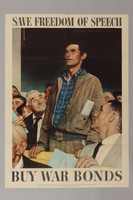
US war bonds poster of a Rockwell painting depicting a man exercising freedom of speech
Object
Four Freedoms war bonds poster featuring an image designed by Norman Rockwell in 1943. The poster shows a man standing to speak at a town meeting, symbolizing the freedom speech. It is one of a four-poster series using Rockwell's paintings, which were inspired by President Roosevelt’s Four Freedoms. He described these in his 1941 State of the Union Address (also called the Four Freedoms Speech): freedom of speech, freedom of worship, freedom from want, and freedom from fear. The United States entered World War II in December 1941, following the attack on Pearl Harbor. The Office of War Information (OWI) was established in June 1942, to control the message and imagery of government information about the war. This office controlled the design and distribution of war information to the American public in print, radio, and film media, and commissioned work from leading artists. Rockwell created a series of sketches about the Four Freedoms to support the war effort, but no one in Washington was interested in using them initially. The paintings were later published by the Saturday Evening Post beginning on February 26, 1943, and then reprinted, with permission, by the OWI. The OWI launched a nationwide tour with the paintings, raising $130 million dollars in war bond sales. They also offered the posters for sale in three different sizes, and four million sets of the posters were printed.
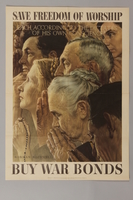
US war bonds poster with Rockwell painting of people of different faiths to promote freedom of worship
Object
Four Freedoms war bonds poster featuring a Norman Rockwell painting of people praying as a symbol of the Freedom of Worship for which we were fighting the war. Some people carry symbols of their faiths: a girl with prayer beads, an old woman with her palms pressed together, and a man in a yarmulke. At the top is the phrase: "Each according to the dictates of his own conscience." It is one of a series of four posters (1988.42.1,3,4) using Rockwell's paintings, inspired by the Four Freedoms described in Roosevelt's 1941 State of the Union Address: freedom of speech, freedom of worship, freedom from want, and freedom from fear. The US entered the war in December 1941, following the attack on Pearl Harbor. The Office of War Information (OWI) was set up in June 1942 to control the message and imagery of government information about the war. Rockwell created a sketches about the Four Freedoms to help the war effort, but no one in Washington was interested. The paintings were published by the Saturday Evening Post beginning February 26, 1943 and then reprinted, with permission, by the OWI. The OWI launched a nationwide tour with the paintings, raising $130 million dollars in war bond sales. They also offered the posters for sale in three different sizes and four million sets of the posters were printed.
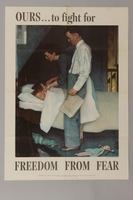
US war bonds poster of a Rockwell painting depicting a couple checking on their sleeping children
Object
Four Freedoms war bonds poster featuring an image designed by Norman Rockwell in 1943. The poster shows a couple checking on their sleeping children, symbolizing the freedom from fear. It is one of a four-poster series using Rockwell's paintings, which were inspired by President Roosevelt’s Four Freedoms. He described these in his 1941 State of the Union Address (also called the Four Freedoms Speech): freedom of speech, freedom of worship, freedom from want, and freedom from fear. The United States entered World War II in December 1941, following the attack on Pearl Harbor. The Office of War Information (OWI) was established in June 1942, to control the message and imagery of government information about the war. This office controlled the design and distribution of war information to the American public in print, radio, and film media, and commissioned work from leading artists. Rockwell created a series of sketches about the Four Freedoms to support the war effort, but no one in Washington was interested in using them initially. The paintings were later published by the Saturday Evening Post beginning on February 26, 1943, and then reprinted, with permission, by the OWI. The OWI launched a nationwide tour with the paintings, raising $130 million dollars in war bond sales. They also offered the posters for sale in three different sizes, and four million sets of the posters were printed.
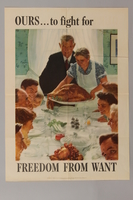
US war bonds poster with Rockwell painting of Thanksgiving dinner to promote freedom from want
Object
Four Freedoms war bonds poster featuring a Norman Rockwell painting of a traditional New England Thanksgiving dinner as a symbol of the Freedom from Want for which we were fighting the war. It is one of a series of four posters (1988.42.1, 2,3) using Rockwell's paintings, inspired by the Four Freedoms described in Roosevelt's 1941 State of the Union Address: freedom of speech, freedom of worship, freedom from want, and freedom from fear. The US entered the war in December 1941, following the attack on Pearl Harbor. The Office of War Information (OWI) was set up in June 1942 to control the message and imagery of government information about the war. Rockwell created sketches about the Four Freedoms to help the war effort, but no one in Washington was interested. The paintings were published by the Saturday Evening Post beginning February 26, 1943 and then reprinted, with permission, by the OWI. The OWI launched a nationwide tour with the paintings, raising $130 million dollars in war bond sales. They also offered the posters for sale in three different sizes and four million sets of the posters were printed.
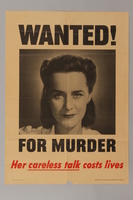
US careless talk poster with a mugshot of a woman wanted for putting lives at risk
Object
US careless talk poster designed like a wanted poster seeking a woman wanted for murder. This poster warns people to guard against what they say in public because spies might get the information. The careless talk series of US propaganda posters was an Army Services project, distributed by the Office of War Information. The need to manage the war on the Home Front led to the establishment of the OWI in June 1942. This office controlled the design and distribution of war information to the American public in posters, photographs, radio shows, and films. They commissioned work from leading artists of the period, including Victor Keppler, the photographer of this work. The careless talk series originated in 1940 in Great Britain. It highlighted the many ways that careless talk could leak sensitive information that our enemies would use to kill soldiers, sink ships, and undermine the war effort.
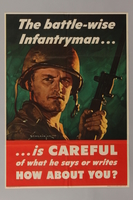
US careless talk poster of a soldier warning people to guard their words
Object
US careless talk poster featuring a helmeted soldier with rifle, in combat, to remind people that their careless talk on the home front could put him in danger on the battlefield. The careless talk series of US propaganda posters was an Army Services project, distributed by the Office of War Information. The need to manage the war on the Home Front led to the establishment of the OWI in June 1942. This office controlled the design and distribution of war information to the American public in posters, photographs, radio shows, and films. They commissioned work from leading artists such as Jes Schlaikjer, who painted this image. In 1942, Schlaikjer became the official Artist of the US War Department. The careless talk series originated in 1940 in Great Britain. It highlighted the many ways that careless talk could leak sensitive information that our enemies would use to kill soldiers, sink ships, and undermine the war effort.
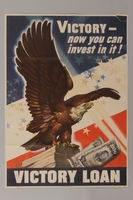
US victory bonds poster depicting a bald eagle on a stack of bonds
Object
Victory loan poster with a bald eagle on a stack of bonds on field of stars and stripes issued near the end of the war encouraging people to invest buy war bonds as an investment. The US entered the war in December 1941, following the attack on Pearl Harbor. The Office of War Information (OWI) was set up in June 1942 to control the message and imagery of government information about the war. The public could purchase a $25 war bond for $18.75 which would help pay for the cost of the war. The bond could be redeemed 10 years after purchase for the full $25. The war in Europe ended May 8 and the war in Japan on September 2.
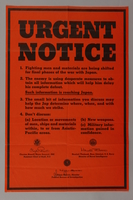
US careless talk text only orange poster insisting on silence about the war on Japan
Object
Text only US careless talk poster warning people that they must say nothing related to the war in Japan: the US was readying for the final phase, the enemy was desperate, and their spies had obtained useful information in the past. This Urgent Notice poster was issued in the name of the directors of Naval Intelligence and the FBI, who were responsible for espionage and counter-espionage. The careless talk series of US propaganda posters began as an Army Services project, distributed by the Office of War Information, which was created in June 1942, to manage the war on the Home Front. OWI controlled the design and distribution of war information to the American public. The careless talk series originated in 1940 in Great Brian. It highlighted the many ways that careless talk could leak sensitive information that our enemies would use to kill soldiers, sink ships, and undermine the war effort.
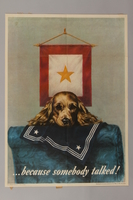
US careless talk poster of a dog with a sailor's uniform, waiting for his return
Object
US careless talk poster with a cocker spaniel's head upon a sailor's navy dress blue collar with a Gold Star service flag to warn people that their behavior can get service personnel killed. The gold star on the flag indicates a family member died in war. Public requests for this poster broke all previous records. The careless talk series of US propaganda posters began as an Army Services project, distributed by the Office of War Information, which was created in June 1942, to manage the war on the Home Front. OWI controlled the design and distribution of war information to the American public in posters, photographs, radio shows, and films. The careless talk series originated in 1940 in Great Britain. It highlighted the many ways that careless talk could leak sensitive information that our enemies would use to kill soldiers, sink ships, and undermine the war effort.
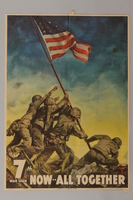
US 7th War Loan poster with an image of marines raising the flag on Iwo Jima
Object
7th War Loan poster using a painting by C.C. Beall based on Joe Rosenthal’s famous photo of the US marines second flag raising on Iwo Jima on February 23, 1945. The campaign for a 7th War Loan subscription took place in May 1945, not long after the end of the war in Europe. The Treasury Department issued posters to encourage the public to buy war bonds. There were 8 war loan drives conducted from 1942 to 1945 and by the end of the war 85 million Americans had purchased 185.7 billion dollars of bonds. The public could purchase a $25 war bond for $18.75 which would be used to help pay for the military’s expenses. The war bond could be redeemed 10 years after the purchase for the full $25. The war in Europe ended May 8, 1945, and the war in Japan on September 2, 1945.
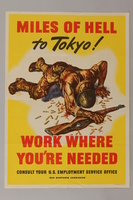
US homefront poster depicting a bloodied, wounded soldier trying to stand
Object
US homefront propaganda poster depicting a soldier, covered with blood and with bullet holes in his uniform issued for the War Manpower Office. The poster reminds civilians of the pain endured and sacrifices being made by soldiers during the war, along with the message that the public should step up and do their part for the war effort. This poster was issued in 1945 when the war in Europe was nearing its end, but the war in the Pacific Theater was far from over. On June 13, 1942 the Office of War Information, OWI, was created with the purpose of communicating the war to the American public by posters, photographs, radio shows, and films. The OWI often employed prominent commercial illustrators, such as Amos Sewell, to create memorable, dramatic images for the posters.
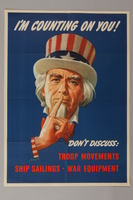
US careless talk poster of Uncle Sam with his finger to his lips asking for silence
Object
US careless talk poster with the Uncle Sam icon with his finger to his mouth in a hushing gesture. This modification of the Uncle Sam image created by Mongomery Flagg for World War I recruitment posters, was designed by Leon Helguera, a Mexican artist who came to America in 1943. The careless talk series was an Army Services project, distributed by the Office of War Information. The need to manage the war on the Home Front led to the establishment of the OWI in June 1942. This office controlled the design and distribution of war information to the American public in all media and commissioned work from leading artists. The careless talk series originated in 1940 in Great Britain. It highlighted the many ways that careless talk could leak sensitive information that our enemies would use to kill soldiers, sink ships, and undermine the war effort.
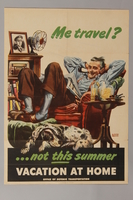
US gas rationing poster with a man reclining on a red armchair
Object
US war rationing poster depicting a man relaxing at home to encourage Americans to vacation at home to save gas. It was produced by the Office of Defense Transportation which was created to improve transportation performance and support war rationing efforts. Because of the need for huge amounts of food and products by the military and our allies, the US rationed materials, such as gasoline and rubber. By May 1942, gas was rationed in 17 states and nationwide by December. Travel was organized into three categories: necessary for military travel and emergencies; permissible for vacation and shopping; and nonessential for social visits and excursions. Gas ration stamps were issued based on the type of travel. The speed limit was reduced to 35 miles per hour to conserve rubber tires. People also were urged to reduce travel to keep roads and railways clear for the movement of troops and material.
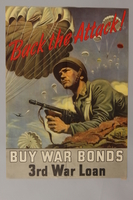
US War Bonds poster of a paratrooper with a Thompson submachine gun at the ready
Object
Poster for the third War Loan drive showing an alert soldier with his gun at the ready in front of a parachute filled sky. The poster was issued by the Treasury Department to encourage the public to buy war bonds for the third War Loan drive, which occurred from September 8 to October 2, 1943. War bonds were sold at 75 percent of their face value, matured over ten years and could then be redeemed for their full purchase value. Bonds were available in denominations of $25 through $1000. If you could not afford a war bond you could buy war stamps, for 10 cents, which could be saved to purchase a bond. There were 8 war loan drives conducted from 1942 to 1945, and by the end of the war 85 million Americans had purchased 185.7 billion dollars of bonds. The war in Europe ended May 8, 1945, and the war in Japan ended on September 2, 1945.
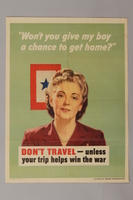
US travel restriction poster with a woman in front of a service flag
Object
US war rationing poster depicting a woman in front of a service flag imploring people to observe travel restrictions so her son can get back home. It was produced by the Office of Defense Transportation which was created to improve transportation performance and support war rationing efforts. Because of the need for huge amounts of food and products by the military and our allies, the US rationed materials, such as gasoline and rubber. By May 1942, gas was rationed in 17 states and nationwide by December. Travel was organized into three categories: necessary for military travel and emergencies; permissible for vacation and shopping; and nonessential for social visits and excursions. Gas ration stamps were issued based on the type of travel. The speed limit was reduced to 35 miles per hour to conserve rubber tires. People also were urged to reduce travel to keep roads and railways clear for the movement of troops and material.
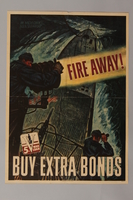
US 5th war loan poster with 2 US sailors on a submarine
Object
Poster for the 5th War Loan campaign featuring two sailors on watch aboard a submarine at night. The poster includes the words: In memory, U.S.S. Dorado. The Dorado was a Gato-class submarine, the first US mass produced submarines of the war. The Dorado launched May 23, 1943, and was lost with all hands in the Caribbean on October 12. It was later discovered that the Dorado was bombed by a US airplane that mistook her for a German U-boat. The Dorado has never been found. The campaign for the 5th War Loan subscription took place from June 12 - July 8, 1944. There were 8 war loan drives from 1942 to 1945. By the end of the war, 85 million Americans had purchased 185.7 billion dollars of bonds.
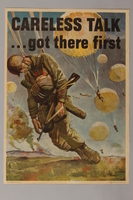
US careless talk poster of a US paratrooper shot in harness
Object
US careless talk poster featuring an American GI in combat dress, hanging lifeless from a parachute, to remind people that their careless talk on the home front could cause death on the battlefield. Issued after the Allied offensive was launched in June 1944, the poster emphasizes the even greater need for be careful and watch out for spies. The careless talk series of US propaganda posters was an Army Services project, distributed by the Office of War Information. The need to manage the war on the Home Front led to the establishment of the OWI in June 1942. This office controlled the design and distribution of war information to the American public and commissioned work from leading artists. The careless talk series originated in 1940 in Great Britain. It highlighted the many ways that careless talk could leak sensitive information that our enemies would use to kill soldiers, sink ships, and undermine the war effort.
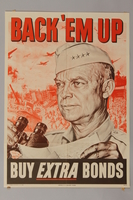
US Buy War Bonds poster with Eisenhower over a drawing of combat troops
Object
Poster from the Buy War Bonds series featuring a drawing of General Eisenhower superimposed over advancing troops. These posters were issued by the United States Treasury Department to encourage the purchase of war bonds and war stamps. There were 8 war loan drives conducted from 1942 to 1945. The public could purchase a $25 war bond for $18.75 which would be used to help pay for the military’s expenses. The war bond could be redeemed 10 years after the purchase for the full $25. Bond quotas were set up on the national, state, county, and town levels to encourage the sale of war bonds. Volunteers went door-to-door to sell war bonds. By the end of the war, 85 million Americans had purchased $185.7 billion dollars worth of bonds.
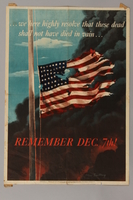
Poster of a tattered US flag and black smoke commemorating Pearl Harbor
Object
Poster commemorating the attack on Pearl Harbor, December 7, 1941, issued by the Office of War Information (OWI) to inspire resolve and motivate the American public in 1942. The poster was created by artist, Allen Saalburg, a muralist who had previously worked with the Works Progress Administration (WPA) to design murals for the Central Park Zoo, the Arsenal building, and other buildings in New York City. The poster features a quote from Abraham Lincoln’s Gettysburg Address. The black smoke and tattered American flag imagery recall the devastation of the Japanese attack on the Naval Base of Pearl Harbor, Hawaii, which killed over 2,000 soldiers, and destroyed approximately 200 planes and nearly 20 ships. The United States entered the war the next day, December 8, and the attack became a rallying cry for the war effort. Conflicting information regarding the attack led President Roosevelt to establish the OWI in June 1942. This office controlled the design and distribution of war information to the American public in print, radio, and film media. The OWI commissioned work from leading artists to create posters to inspire and instill confidence and patriotism in the American public. The OWI also ran information campaigns for civilian agencies, War Bond drives, and campaigns to ramp up economic production for the war effort. New posters were distributed every two weeks, with the stated goal of placing posters in every city and town in the United States.
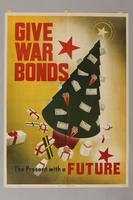
US Buy War Bonds poster depicting a Christmas tree full of war bonds
Object
US Buy War Bonds poster with a Christmas tree decorated with war bonds and stamps issued by the Treasury Department to encourage the public to buy war bonds. War bonds could be redeemed 10 years after purchase for the full $25. If you could not afford a war bond you could buy a war stamps, starting at 10 cents, which could be saved to purchase a bond. There were 8 war loan drives conducted from 1942 to 1945 and by the end of the war 85 million Americans had purchased 185.7 billion dollars of bonds. The war in Europe ended May 8, 1945, and the war in Japan on September 2, 1945.
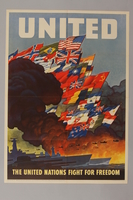
US poster of black smoke around displayed national flags
Object
US propaganda poster depicting the flags of the world rising triumphantly out of the smoking fires of war as the United Nations. It was issued by the Office of War Information as a symbol of the unity of the Allied forces against their common enemies. On January 1, 1942, representatives of the US, Great Britain, Soviet Union, and China signed the United Nations Declaration, joined the next day by 22 other nations. In this document, the signatory governments pledged to exert the maximum war effort and not to make a separate peace. The United Nations was founded 3 years later. The OWI was created in 1942 to control the design and distribution of war information to the American public and commissioned work, such as this painting, from leading artists.
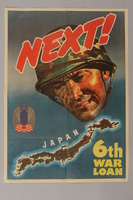
US 6th War loan poster of a soldier glaring at a map of Japan
Object
Poster for the 6th War Loan campaign depicting a the face of a helmeted soldier overprinted with Next floating above an image Japan. The campaign for the 6th War Loan subscription took place from November 20 - December 16, 1944. There were 8 war loan drives from 1942 to 1945. By the end of the war, 85 million Americans had purchased 185.7 billion dollars of bonds.he Treasury Department issued posters to encourage the public to buy war bonds. There were 8 war loan drives conducted from 1942 to 1945 and by the end of the war 85 million Americans had purchased 185.7 billion dollars of bonds. The war in Europe ended May 8, 1945, and the war in Japan on September 2, 1945.
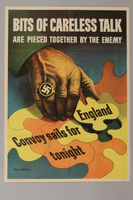
Security of War Information Campaign poster about safeguarding convoy movement information
Object
Security of War Information Campaign poster warning people to guard what they say in public because it could lead to the death of military personnel. The poster was designed by Stevan Dohanos, an illustrator and painter known for his “American Realist” style and depictions of everyday life. The poster was part of the Security of War Information Campaign, also known as the “hush-hush campaign.” This cooperative project was undertaken by the Office of War Information (OWI) with the oversight of a Security Committee, which included representatives from the OWI, the Army, Navy, FBI, and other agencies. The campaign focused on educating the public about the need for discretion in their communication to prevent information from being leaked to the enemy. The need to manage information about the war on the home front led to the establishment of the OWI in June 1942. This office controlled the design and distribution of war information to the American public in print, radio, and film media, and commissioned work from leading artists. The American campaign drew on themes from the British “careless talk series” of 1940. It highlighted the many ways that careless talk could leak sensitive information that enemies would use to kill soldiers, sink ships, and undermine the war effort.
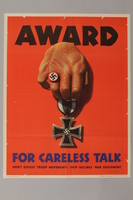
US careless talk poster of a Nazi ringed hand with an Iron Cross
Object
US careless talk poster featuring a hand with a swastika ring completing a jigsaw puzzle that with words: Convoy sails for England tonight, to illustrate how the enemy can gather small details and get important information. The careless talk series of US propaganda posters was an Army Services project, distributed by the Office of War Information. This office was set up in June 1942 to manage the war on the Home Front by disseminating ideas, propaganda, and information about the war effort, such as the dangers of enemy spies. The OWI controlled the design and distribution of war information to the American public in posters, photographs, radio shows, and films. The careless talk series originated in 1940 in Great Britain. It highlighted the many ways that careless talk could leak sensitive information that our enemies would use to kill soldiers, sink ships, and undermine the war effort.
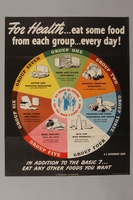
Eat the Basic 7 poster with a pie chart of food groups
Object
Eat the Basic 7 poster issued by the United States Department of Agriculture during World War II (1939-1945.) Food groups were color coded as in this pie chart, to make them easier to remember. In 1942, the Emergency Price Control Act was passed and the Office of Price Administration began rationing food and other goods to make sure they were available to aid Allies and to supply the military. From March 1943-June 1945, the War Food Administation was set up to handle food production and distribution for civilian and war needs. People were encouraged to grow Victory Gardens due to farm labor, transportation, and food shortages. Nutrition programs were introduced to educate the public about healthful eating, food preservation, and efficient food usage to reduce waste. Ration stamps for food purchase were introduced to regulate food consumption. Food rationing continued in the US until after the war in 1946.
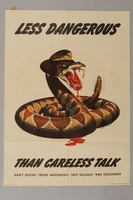
US propaganda poster showing careless talk is more dangerous than a rattlesnake
Object
US careless talk poster with an image of a coiled rattlesnake with blood dripping fangs warning people that sharing war related information was even more dangerous than this snake. The careless talk series of US propaganda posters was an Army Services project, distributed by the Office of War Information, which was created in June 1942 to manage the war on the Home Front. The OWI controlled the design and distribution of war information to the American public in all formats. The goal was to place posters in street level windows of every business in every town across the United States. Posters were exchanged every two weeks, and artwork was commissioned from leading artists. The careless talk series originated in 1940 in Great Britan. It highlighted the many ways that careless talk could leak sensitive information that our enemies would use to kill soldiers, sink ships, and undermine the war effort.
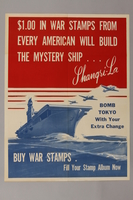
US Retailers for Victory poster of the carrier Shangri-La on a red, white, and blue background
Object
Red, white, and blue poster with the aircraft carrier Shangri-La from the Retailers for Victory poster series issued by the US Treasury Department to encourage the purchase of war bonds and war stamps. In 1943, there was a War Stamp Drive to support the construction of the aircraft carrier Shangri-La. The ship was laid down by the Norfolk Navy Yard, in Portsmouth, VA, on January 15, 1943 and launched on February 24, 1944. It saw service in the Pacific Theater, and its aircraft bombed many Japanese cities in 1945 on the northern Japanese main islands, Hokkaido and Honshu, including Tokyo. During World War II, war bonds were issued by the government to help pay for the war effort. The public could purchase a $25 war bond for $18.75 which would help pay the military’s expenses. The war bond could be redeemed 10 years after the purchase for the full $25. For people who could not afford $18.75, war stamps could be bought, starting at 10 cents, and saved to purchase a war bond. By the end of the war, 85 million Americans had purchased $185.7 billion dollars of bonds.
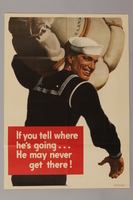
US careless talk poster with a smiling sailor ready to sail
Object
US careless talk poster featuring an American sailor in blue uniform and white Dixie cap as a smiling reminder of the life you put at risk with loose talk on the home front. This poster was drawn by John Falter, an established illustrator and also an enlisted man who designed over 300 posters for the government. The careless talk series of US propaganda posters was an Army Services project, distributed by the Office of War Information. The need to manage the war on the Home Front led to the establishment of the OWI in June 1942. This office controlled the design and distribution of war information to the American public in all media and commissioned work from leading artists of the period. The careless talk series originated in 1940 in Great Britain. It highlighted the many ways that careless talk could leak sensitive information that our enemies would use to kill soldiers, sink ships, and undermine the war effort.
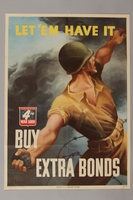
US 4th War Loan poster with a soldier throwing a grenade
Object
Poster for the 4th War Loan campaign with a soldier preparing to throw a hand grenade. The campaign for the 4th War Loan subscription took place from January 18 - February 15, 1944. The Treasury Department issued posters to encourage the public to buy war bonds. There were 8 war loan drives conducted from 1942 to 1945 and by the end of the war 85 million Americans had purchased 185.7 billion dollars of bonds. Bernard Perlin who created the painting used in this poster later became a war artist correspondent for Life and Fortune magazines, and went to combat zones in Greece, the South Pacific, and Asia.
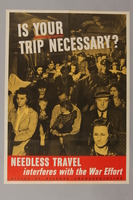
US Don’t Travel poster depicting civilians and soldiers on a crowded train
Object
Poster from the Don’t Travel series depicting civilians and soldiers traveling on a crowded railcar produced by the Office of Defense Transportation. This office was involved in improving transportation performance and supporting war rationing efforts. Travel was organized into three categories: necessary for military travel and emergencies; permissible for vacation and shopping; and nonessential for social visits and excursions. By late in the war, more than 300,000 railroad workers were in the armed forces and there was a shortage of manpower for the railroads. The ODT stopped the operation of special event trains and limited of extra trains on heavily traveled routes.
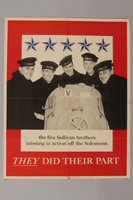
Recruitment poster with the 5 Sullivan brothers
Object
US recruitment poster with a photograph of the five Sullivan brothers, sailors on the U.S.S. Juneau, in 1942. The ship was on its way from New Caledonia to Guadalcanal in the South Pacific when, on the morning of November 13, 1942, it was struck by a Japanese torpedo. All 5 brothers were killed in the attack. It became a national story and a rallying point for the war effort. The poster was issued by the Office of War information which was created in June 1942 to manage the war on the Home Front by disseminating ideas, propaganda, and information about the war effort. The OWI’s goal was to place posters in the street-level windows of every store, office, and restaurant in every city and town across the United States.
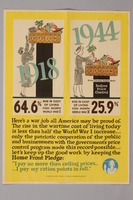
US price control poster
Object
This poster is part of the price control program established by the Office of Price Administration in the US during World War II. The OPA was formed on August 28, 1941 by President Roosevelt’s Executive Order 8875. After the passage of the Emergency Price Control Act on January 30, 1942, the OPA tried to counteract the rising prices of food and commodities by introducing rationing and fixing price ceilings on goods. The combination of shipping food and commodities to our troops and allies and the high priority placed on military goods left a scarcity of supplies on the US home front. The OPA developed a local board system in every county and almost every city and town in the US to administer price control and rationing. Price panel assistants would visit local stores to make sure that prices were adjusted accordingly, and report those that were not. The government sent ration tables and price control posters, such as this one, to retailers who would hang them on the walls for the public. Price control continued until November 9, 1946 when President Truman signed an executive order ending all wage and price controls except on rents, sugar, and rice.
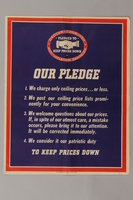
US price control poster with white text against a blue background
Object
This poster is part of the price control program established by the Office of Price Administration in the US during World War II. The OPA was formed on August 28, 1941 by President Roosevelt’s Executive Order 8875. After the passage of the Emergency Price Control Act on January 30, 1942, the OPA tried to counteract the rising prices of food and commodities by introducing rationing and fixing price ceilings on goods. The combination of shipping food and commodities to our troops and allies and the high priority placed on military goods left a scarcity of supplies on the US home front. The OPA developed a local board system in every county and almost every city and town in the US to administer price control and rationing. Price panel assistants would visit local stores to make sure that prices were adjusted accordingly, and report those that were not. Despite OPA’s price ceilings, prices for some food items continued to rise until April 8, 1943 when President Roosevelt signed his Hold the Line order, Executive Order 9328, which stopped all rising prices for food. Price control continued until November 9, 1946 when President Truman signed an executive order ending all wage and price controls except on rents, sugar, and rice.
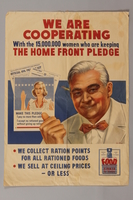
US price control poster depicting a grocer pointing to a pledge
Object
This poster is part of the price control program established by the Office of Price Administration in the US during World War II. The man is pointing to a Make This Pledge poster which was distributed by the OPA in 1943. The OPA was formed on August 28, 1941 by President Roosevelt’s Executive Order 8875. After the passage of the Emergency Price Control Act on January 30, 1942, the OPA tried to counteract the rising prices of food and commodities by introducing rationing and fixing price ceilings on goods. The combination of shipping food and commodities to our troops and allies and the high priority placed on military goods left a scarcity of supplies on the US home front. The OPA developed a local board system in every county and almost every city and town in the US to administer price control and rationing. Price panel assistants would visit local stores to make sure that prices were adjusted accordingly, and report those that were not. Despite OPA’s price ceilings, prices for some food items continued to rise until April 8, 1943 when President Roosevelt signed his Hold the Line order, Executive Order 9328, which stopped all rising prices for food. Price control continued until November 9, 1946 when President Truman signed an executive order ending all wage and price controls except on rents, sugar, and rice.
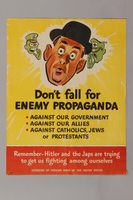
American propaganda poster with anti-Nazi and anti-Japanese caricatures
Object
American propaganda poster urging the public to be alert for enemy propaganda, designed by Jack Betts and distributed in 1943 by Veterans of Foreign Wars of the United States (VFW). The poster uses the caricatured faces of Nazi dictator, Adolf Hitler, and Japanese emperor, Hirohito, whispering into a man’s ear as symbols of enemy propaganda reaching the American public. The poster warns the reader that enemy propaganda attempts to divide Americans and turn them against their government and each other. During the war, the government was concerned about the effects of German and Japanese propaganda on the American public. Radio was an important tool, and Imperial Japan and Nazi Germany used native English speakers to broadcast radio messages to the soldiers and the public, spreading disinformation and creating fear. Like the Avoid Careless Talk poster series created by the Office of War Information, it reminds the public of the vital part they play in the war effort. The VFW supported the war effort at home by creating posters, encouraging enlistments, raising money, and establishing an Aviation Cadet program to train and educate young pilots. Jack Betts was an American illustrator and artist who created advertising comics, and illustrations for magazines.
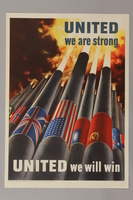
US propaganda poster with artillery gun barrels draped in Allied flags
Object
US and Allied Nations propaganda poster with an image of antiaircraft or artillery gun barrels wrapped in Allied flags. It was issued by the Office of War Information as a symbol of the unity of the Allied forces against their common enemies, the Axis powers. Henry Koerner, the artist, was an Austrian Jewish emigre artist who joined the OWI in 1943. On January 1, 1942, the US, Great Britain, Soviet Union, and China signed the United Nations Declaration, joined the next day by 22 other nations. The signatory governments pledged to exert the maximum war effort and not to make a separate peace. The United Nations was founded 3 years later. The need to manage the war on the Home Front led to the establishment of the OWI in June 1942. This office controlled the design and distribution of war information to the American public in posters, photographs, radio shows, and films. They commissioned work from leading artists and the posers were distributed to retailers for display.
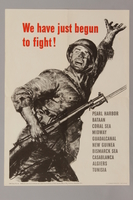
Poster depicting a soldier and a list of battles
Object
This poster was the 62nd poster distributed by the United States Office of War Information during World War II. It was created to inspire hope and enlistments among the US public by listing the names of important battles showing the advance of Allied troops from the disaster of Pearl Harbor on Dec. 7, 1941 to the battle of Tunisia which ended on May 13, 1943 when all the Axis forces in North Africa surrendered. Posters like this were created by the OWI and distributed to retail businesses which would hang them on the walls. The OWI’s goal was to place posters in the street-level windows of every store, office, and restaurant in every city and town across the United States. They created several series of posters which they printed and distributed to stores through collaboration with organizations such as the Boy Scouts of America.
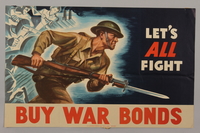
US Buy War Bonds poster of a soldier charging, bayonet ready
Object
Poster from the Buy War Bonds series featuring a grim faced US soldier lunging forward, rifle bayonet at the ready, factory workers at his back. These posters were issued by the United States Treasury Department to encourage the purchase of war bonds and war stamps. There were 8 war loan drives conducted from 1942 to 1945. The public could purchase a $25 war bond for $18.75 which would be used to help pay for the military’s expenses. The war bond could be redeemed 10 years after the purchase for the full $25. Bond quotas were set up on the national, state, county, and town levels to encourage the sale of war bonds. Volunteers went door-to-door to sell war bonds. By the end of the war, 85 million Americans had purchased $185.7 billion dollars worth of bonds. The war in Europe ended May 8, 1945, and the war in Japan on September 2, 1945.
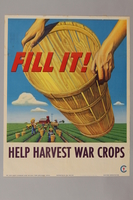
War Food poster with a basket over a field being harvested
Object
War Food Administration poster urging people to help harvest farm crops to aid the war effort and to send to the soldiers overseas. In 1942, the Emergency Price Control Act was passed and the US began rationing food and other goods to make sure they were available to aid Allies and to supply the military. From March 1943-June 1945, the War Food Administration was set up to handle food production and distribution for civilian and war needs. People were encouraged to grow Victory Gardens due to farm labor, transportation, and food shortages. Nutrition programs were introduced to educate the public about healthful eating, food preservation, and efficient food usage to reduce waste. Ration stamps for food purchase were introduced to regulate food consumption. Posters such as this were distributed to retailers and public groups for display.
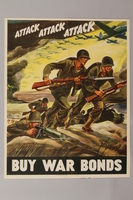
US Buy War Bonds poster of soldiers charging into battle
Object
Poster from the Buy War Bonds series featuring US soldiers advancing on a beachhead during combat. These posters were issued by the United States Treasury Department to encourage the purchase of war bonds and war stamps. There were 8 war loan drives conducted from 1942 to 1945. The public could purchase a $25 war bond for $18.75 which would be used to help pay for the military’s expenses. The war bond could be redeemed 10 years after the purchase for the full $25. Bond quotas were set up on the national, state, county, and town levels to encourage the sale of war bonds. Volunteers went door-to-door to sell war bonds. By the end of the war, 85 million Americans had purchased $185.7 billion dollars worth of bonds. The war in Europe ended May 8, 1945, and the war in Japan on September 2, 1945.
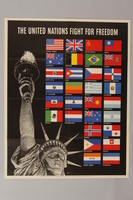
US poster depicting the Statue of Liberty and flags of Allied Nations
Object
Poster depicting the Statue of Liberty and the flags of 30 of the first 31 (Iraq’s flag is not pictured) countries who had declared war on the Axis Powers, and signed the Declaration by the United Nations (an alternate term to describe the Allied Powers). The Declaration pledged the signatories to employ their full resources to the war effort, and prevented them from making a separate peace. The poster was designed by Steve Broder, a Canadian artist working in the United States. The need to manage information about the war on the home front led to the establishment of the OWI in June 1942. This office controlled the design and distribution of war information to the American public in print, radio, and film media. The OWI commissioned work from leading artists to create posters to inspire and instill confidence and patriotism in the American public. The OWI also ran information campaigns for civilian agencies, War Bond drives, and campaigns to ramp up economic production for the war effort. New posters were distributed every two weeks, with the stated goal of placing posters in every city and town in the United States.
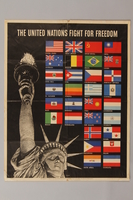
US poster depicting the Statue of Liberty and flags of Allied Nations
Object
Poster depicting the Statue of Liberty and the flags of 30 of the first 31 (Iraq’s flag is not pictured) countries who had declared war on the Axis Powers, and signed the Declaration by the United Nations (an alternate term to describe the Allied Powers). The Declaration pledged the signatories to employ their full resources to the war effort, and prevented them from making a separate peace. The poster was designed by Steve Broder, a Canadian artist working in the United States. The need to manage information about the war on the home front led to the establishment of the OWI in June 1942. This office controlled the design and distribution of war information to the American public in print, radio, and film media. The OWI commissioned work from leading artists to create posters to inspire and instill confidence and patriotism in the American public. The OWI also ran information campaigns for civilian agencies, War Bond drives, and campaigns to ramp up economic production for the war effort. New posters were distributed every two weeks, with the stated goal of placing posters in every city and town in the United States.
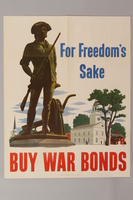
Buy War Bonds poster with an image of the Concord militiaman statue
Object
Poster from the Buy War Bonds poster series issued by the War Finance division of the US Treasury to encourage the purchase of war bonds and war stamps to support the war effort. It depicts the symbol of the US Savings Bond program, the Minute Man statue by Daniel Chester French in Concord, Massachusetts. Professional artists were commissioned to create art for the posters which were distributed to retailers to display. There were 8 war loan drives conducted from 1942 to 1945. The public could purchase a $25 war bond for $18.75 to help pay the military’s expenses. The war bond could be redeemed 10 years after the purchase for the full $25. Bond quotas were set up on the national, state, county, and town levels to encourage the sale of war bonds. It was considered a patriotic duty and an investment in victory. By the end of the war, 85 million Americans had purchased $185.7 billion dollars worth of bonds.
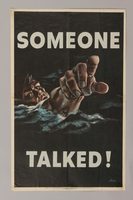
US careless talk poster depicting a drowning sailor pointing at the viewer
Object
US careless talk poster with an image of a drowning sailor to warn people to guard what they say in public because it could lead to the death of military personnel. The careless talk series of US propaganda posters was an Army Services project, distributed by the Office of War Information. The need to manage the war on the Home Front led to the establishment of the OWI in June 1942. This office controlled the design and distribution of war information to the American public in all media and commissioned work from leading artists, such as Frederick Siebel, who painted this image. Siebel was an Austrian born artist who came to the US in 1936. His design was the winning entry in a competition put on by Devoe & Reynolds Painting Company, judged by Eleanor Roosevelt. The careless talk series originated in 1940 in Great Britain. It highlighted the many ways that careless talk could leak sensitive information that our enemies would use to kill soldiers, sink ships, and undermine the war effort.
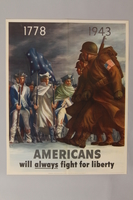
US propaganda poster depicting World War II and Revolutionary War soldiers
Object
US propaganda poster featuring World War II soldiers marching in front of Revolutionary War soldiers. The poster associates World War II soldiers with Continental Army soldiers and, with the large caption, implies that the United States was fighting in World War II for the same reasons the nation fought the Revolutionary War at the end of the 18th century. The image was created by American-Jewish artist, Bernard Perlin, who studied at the Art Students League in New York and created post office murals for the Works Projects Administration (WPA) prior to the war. During the war, he created pro-war propaganda for the Office of War information (OWI), and later served as a war artist correspondent for Life and Fortune magazines. The need to manage information about the war on the home front led to the establishment of the OWI in June 1942. This office controlled the design and distribution of war information to the American public in print, radio, and film media. The OWI commissioned work from leading artists to create posters to inspire and instill confidence and patriotism in the American public. The OWI also ran information campaigns for civilian agencies, War Bond drives, and campaigns to ramp up economic production for the war effort. New posters were distributed every two weeks, with the stated goal of placing posters in every city and town in the United States.
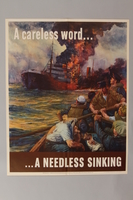
US careless talk poster depicting a burning ship
Object
US careless talk poster depicting sailors in ripped clothing in a lifeboat with a burning tanker nearby as a warning to people to guard what they say because it could put military personnel in danger. The careless talk series of US propaganda posters was an Army Services project, distributed by the Office of War Information. This office was set up in June 1942 to manage the war on the Home Front by disseminating ideas, propaganda, and information about the war effort, such as the dangers of enemy spies. The OWI controlled the design and distribution of war information to the American public in posters, photographs, radio shows, and films. The careless talk series originated in 1940 in Great Britain. It highlighted the many ways that careless talk could leak sensitive information that our enemies would use to kill soldiers, sink ships, and undermine the war effort.
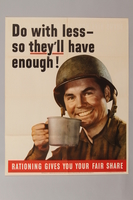
US poster depicting a smiling soldier holding a silver canteen cup
Object
US poster featuring a helmeted soldier with a big grin on his face holding a canteen cup to his mouth encouraging the public to conserve food to help feed the soldiers. This poster was part of a series distributed by the Office of War Information. The need to manage the war on the Home Front led to the establishment of the OWI in June 1942. This office controlled the design and distribution of war information to the American public in posters, photographs, radio shows, and films. They commissioned work from leading artists of the period to create posters. The man in this photo is Thomas J. Murray who was the portrayal for GI Joe and served as the face for war rationing on many posters from 1943-1945.
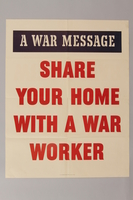
US poster with text encouraging the sharing of homes
Object
Text only US poster encouraging people to share their homes with a war worker. This poster was part of a campaign launched by the National Housing Agency entitled “Share Your Home” which encouraged families to house migrant workers from nearby factories. American factories built or expanded their facilities to accommodate huge war contracts which attracted thousands of migrant workers who traveled to cities such as Los Angeles, Detroit, and Baltimore. To accommodate the huge influx of workers, the government began building war worker housing, converting single family homes to support 2 or more families, imposing rent control, and encouraging the public to house workers.
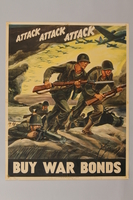
US Buy War Bonds poster depicting charging soldiers
Object
Poster from the Buy War Bonds series featuring US soldiers advancing on a beachhead during combat. The posters were issued by the United States Treasury Department to encourage the purchase of war bonds and war stamps. Professional artists were commissioned to create art for the posters which were distributed to retailers to display. There were 8 war loan drives conducted from 1942 to 1945. The public could purchase a $25 war bond for $18.75 to help pay for the military’s expenses. The war bond could be redeemed 10 years after purchase for the full $25. Bond quotas were set up on the national, state, county, and town levels to encourage the sale of war bonds. Volunteers went door-to-door to sell war bonds. It was considered a patriotic duty and an investment in victory. By the end of the war, 85 million Americans had purchased $185.7 billion dollars worth of bonds.
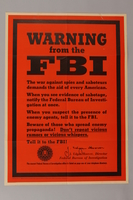
US careless talk text only orange poster warning about suspicious people
Object
US careless talk text only poster warning people to watch out for and report any suspicious people or rumors co-produced with the FBI [Federal Bureau of Investigation] and the Office of War Information. It was part of the careless talk series of US propaganda posters distributed by the OWI, set in June 1942 to manage the war on the Home Front by disseminating ideas, propaganda, and information about the war, such as the dangers of enemy spies. The OWI controlled the design and distribution of war information to the American public in posters, photographs, radio shows, and films. The careless talk series originated in 1940 in Great Britain. It highlighted the many ways that careless talk could leak sensitive information that our enemies would use to kill soldiers, sink ships, and undermine the war effort.
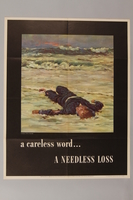
US careless talk poster with a dead US sailor on a beach
Object
US careless talk poster depicting a dead US sailor washed near shore warning the public to guard what they say in public because it could lead to battlefield deaths. The careless talk series of US propaganda posters was an Army Services project, distributed by the Office of War Information. The need to manage the war on the Home Front led to the establishment of the OWI in June 1942. This office controlled the design and distribution of war information to the American public in posters, photographs, radio shows, and films. They commissioned work from leading artists of the period, including Anton Otto Fischer, who painted this image. Fischer was a German born artist who immigrated to the United States and painted patriotic posters for the government during both World Wars. The careless talk series originated in 1940 in Great Britain. It highlighted the many ways that careless talk could leak sensitive information that our enemies would use to kill soldiers, sink ships, and undermine the war effort.
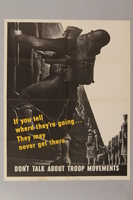
US careless talk poster depicting soldiers boarding a train
Object
US careless talk poster featuring a train with a line of soldiers preparing to board to warn the public to guard what they say because any bit of information could endanger soldiers. The careless talk series of US propaganda posters was an Army Services project, distributed by the Office of War Information. This office was set up in June 1942 to manage the war on the Home Front by disseminating ideas, propaganda, and information about the war effort, such as the dangers of enemy spies. The OWI controlled the design and distribution of war information to the American public in posters, photographs, radio shows, and films. The careless talk series originated in 1940 in Great Britain. It highlighted the many ways that careless talk could leak sensitive information that our enemies would use to kill soldiers, sink ships, and undermine the war effort.
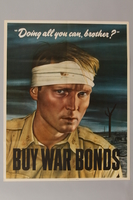
Buy War Bonds poster of a bandaged soldier
Object
US “Buy War Bonds” poster of a soldier with a white bandage around his head. The posters were issued by the United States Treasury Department to encourage the purchase of war bonds and war stamps. Professional artists were commissioned to create art for the posters which were distributed to retailers to display. There were 8 war loan drives conducted from 1942 to 1945. The public could purchase a $25 war bond for $18.75 to help pay for the military’s expenses. The war bond could be redeemed 10 years after purchase for the full $25. Bond quotas were set up on the national, state, county, and town levels to encourage the sale of war bonds. Volunteers went door-to-door to sell war bonds. It was considered a patriotic duty and an investment in victory. By the end of the war, 85 million Americans had purchased $185.7 billion dollars worth of bonds.
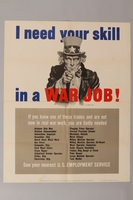
US poster depicting Uncle Sam and a list of military occupations
Object
US poster depicting Uncle Sam and a list of military occupations below encouraging the public with the necessary skills to apply for these positions. The poster is part of the US propaganda posters distributed by the Office of War Information. The need to manage the war on the Home Front led to the establishment of the OWI in June 1942. This office controlled the design and distribution of war information to the American public in posters, photographs, radio shows, and films. They commissioned work from leading artists of the period. This poster uses the Uncle Sam image made famous by James Montgomery Flagg. As millions of men entered military service, the government and industry waged a concerted campaign to obtain as many applicants for jobs as possible. The number of working women rose by about 6.5 million from 1941 to 1945. By mid-1945 the United States had produced 80,000 landing craft, 100,000 tanks and armored cars, 300,000 airplanes, 15 million guns, and 41 billion rounds of ammunition.
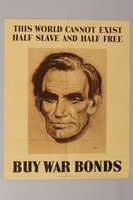
Buy War Bonds poster with portrait of Abraham Lincoln
Object
Poster from the Buy War Bonds series with a portrait of Abraham Lincoln. The posters were issued by the United States Treasury Department to encourage the purchase of war bonds and war stamps. Professional artists were commissioned to create art for the posters which were distributed to retailers to display. There were 8 war loan drives conducted from 1942 to 1945. The public could purchase a $25 war bond for $18.75 to help pay for the military’s expenses. The war bond could be redeemed 10 years after purchase for the full $25. Bond quotas were set up on the national, state, county, and town levels to encourage the sale of war bonds. Volunteers went door-to-door to sell war bonds. It was considered a patriotic duty and an investment in victory. By the end of the war, 85 million Americans had purchased $185.7 billion dollars worth of bonds.
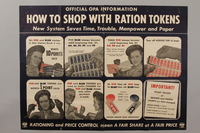
Poster instructing how to use ration tokens
Object
This poster is part of the rationing program established by the Office of Price Administration in the US during World War II. It was mailed to food retailers who were required to hang it on the walls of their shop for public viewing. To counteract rising food prices, the OPA introduced ration stamps; blue for processed foods and red for meats and fats. Ration stamps, in book form, were issued to every man, woman, and child to be used to buy food, and retailers would give back ration tokens as change. Each stamp had a number designating the points it was worth and a letter showing the exact period during which it could be used. In order to discourage hoarding, trading, and selling of stamps, the government expected people to destroy their extra ration stamps each month. Rationing was slowly phased out after the war until November 9, 1946 when President Truman signed an executive order ending all wage and price controls except on rents, sugar, and rice.
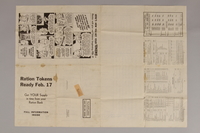
US ration point guide poster with tables for February 1944
Object
This poster is part of the rationing program established by the Office of Price Administration in the US during World War II describing the food ration points effective January 30, 1944. The OPA mailed official tables to food retailers before every ration period, who were required to hang it on the walls for public viewing, which outlined the price and ration point value for each food for the upcoming period. To counteract rising food prices, the OPA fixed price ceilings and introduced ration stamps. Ration stamps, in book form, were issued to every man, woman, and child to be used to buy food. Each stamp had a number designating the points it was worth and a letter showing the exact period during which it could be used. The customer would purchase food and hand over the amount of ration points, which the retailer would use to purchase merchandise. Rationing was slowly phased out after the war until November 9, 1946 when President Truman signed an executive order ending all wage and price controls except on rents, sugar, and rice.
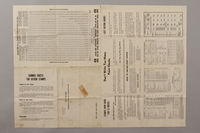
US ration point guide poster with tables for April 1944
Object
This poster is part of the rationing program established by the Office of Price Administration in the US during World War II describing the food ration points effective April 2, 1944. The OPA mailed official tables to food retailers before every ration period, who were required to hang it on the walls for public viewing, which outlined the price and ration point value for each food for the upcoming period. To counteract rising food prices, the OPA fixed price ceilings and introduced ration stamps. Ration stamps, in book form, were issued to every man, woman, and child to be used to buy food. Each stamp had a number designating the points it was worth and a letter showing the exact period during which it could be used. The customer would purchase food and hand over the amount of ration points, which the retailer would use to purchase merchandise. Rationing was slowly phased out after the war until November 9, 1946 when President Truman signed an executive order ending all wage and price controls except on rents, sugar, and rice.
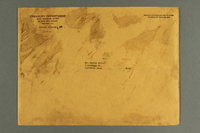
Envelope with Treasury Department War Savings Staff label
Object
Paper envelope with printed postal information used to mail US war posters. It was issued by the Treasury Department and distributed by the Office of War Information. On June 13, 1942 the OWI was created with the purpose of communicating the war to the American public by posters, photographs, radio shows, and films. They commissioned work from leading artists of the period. The OWI’s goal was to place posters in the street-level windows of every store, office, and restaurant in every city and town across the United States. The posters would be exchanged for new ones every two weeks.

Light brown paper envelope used for mailing war posters
Object
Paper envelope with printed postal information used to mail US war posters distributed by the Office of War Information. On June 13, 1942 the OWI was created with the purpose of communicating the war to the American public by posters, photographs, radio shows, and films. They commissioned work from leading artists of the period. The OWI’s goal was to place posters in the street-level windows of every store, office, and restaurant in every city and town across the United States. The posters would be exchanged for new ones every two weeks.
Handbill
Object



